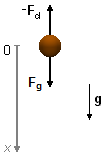Solved Problem on Dynamics
advertisement
A particle of mass m is released at rest and falls under the action of the force of gravity, and force of resistance proportional to falling speed. Determine:
a) The equation of velocity as a function of time;
b) The terminal velocity;
c) The equation of displacement as a function of time;
d) The acceleration of motion.
Problem data:
- Mass of the particle: m;
- Initial speed of the particle: v0 = 0;
- Drag coefficient: b.
We choose a reference frame pointing downward with origin at the point where the particle is released.
In the particle acts the gravitational force Fg in the direction of the fall and the
drag force Fd in the opposite direction of motion.

Figure 1
a) Applying Newton's Second Law
\[ \bbox[#99CCFF,10px]
{{\mathbf F}=m\mathbf{\dot v}}
\]
\[
{\mathbf F}_{g}-{\mathbf F}_{d}=m\mathbf{\dot v}
\]
the gravitational force is given by
\[ \bbox[#99CCFF,10px]
{{\mathbf F}_{g}=m{\mathbf g}}
\]
and drag force is given by
\[ \bbox[#99CCFF,10px]
{{\mathbf F}_{d}=b{\mathbf v}}
\]
substituting these expressions
\[
mg\;{\mathbf j}-bv\;{\mathbf j}=m {\dot v}\;{\mathbf j}
\]
as there is motion only in one dimension, we have magnitude
\[
mg-bv=m {\dot v}
\]
writing \( {\dot v}=\frac{dv}{dt} \) and separating the variables
\[
\begin{gather}
mg-bv=m\frac{dv}{dt}\\
m\frac{dv}{dt}=b\left(\frac{mg}{b}-v\right)\\
\frac{dv}{\left(\dfrac{mg}{b}-v\right)}=\frac{b}{m}dt
\end{gather}
\]
integrating the left-hand side from 0 to v(t), the speed at any instant t any, and on
the right-hand side integrating the time from 0 to t, any instant t
\[
\begin{gather}
\int_{0}^{{v(t)}}{\frac{dv}{\left(\dfrac{mg}{b}-v\right)}}=\int_{0}^{t}{\frac{b}{m}dt}\\
\int_{0}^{{v(t)}}{\frac{dv}{\left(\dfrac{mg}{b}-v\right)}}=\frac{b}{m}\int_{0}^{t}{dt}
\end{gather}
\]
Integration of \( \displaystyle \int_{0}^{{v(t)}}{\dfrac{dv}{\left(\dfrac{mg}{b}-v\right)}} \)
Changing the variable
for \( v=0 \)
we have \( u=\dfrac{mg}{b} \)
for \( v=v(t) \)
we have \( u=\dfrac{mg}{b}-v(t) \)
substituting in the integral
Changing the variable
\[
\begin{array}{l}
u=\dfrac{mg}{b}-v\\
\dfrac{du}{dv}=-1\Rightarrow dv=-du
\end{array}
\]
changing the limits of integration
for \( v=0 \)
we have \( u=\dfrac{mg}{b} \)
for \( v=v(t) \)
we have \( u=\dfrac{mg}{b}-v(t) \)
substituting in the integral
\[
\begin{split}
\int_{{\frac{mg}{b}}}^{{\frac{mg}{b}-v(t)}}{\frac{-du}{u}} &=-\left[\left.\ln u\;\right|_{\;\frac{mg}{b}}^{\;\frac{mg}{b}-v(t)}\right]=-\left[\ln\left(\frac{mg}{b}-v(t)\right)-\ln\left(\frac{mg}{b}\right)\right]=\\
&=-\ln\left(\frac{\dfrac{mg}{b}-v(t)}{\dfrac{mg}{b}}\right)=-\ln\left(\frac{\dfrac{mg-bv(t)}{\cancel{b}}}{\dfrac{mg}{\cancel{b}}}\right)=\\
&=-\ln\left(\frac{mg-bv(t)}{mg}\right)
\end{split}
\]
Integration of \( \displaystyle \int_{0}^{t}{dt'} \)
\[
\int_{0}^{t}{dt'}=\left.t'\;\right|_{\;0}^{\;t}=t-0=t
\]
\[
\begin{gather}
-\ln\left(\frac{mg-bv(t)}{mg}\right)=\frac{b}{m}t\\[5pt]
\ln\left(\frac{mg-bv(t)}{mg}\right)=-{\frac{b}{m}}t\\[5pt]
\frac{mg-bv(t)}{mg}=\operatorname{e}^{-{\frac{b}{m}}t}\\[5pt]
mg-bv(t)=mg\operatorname{e}^{-{\frac{b}{m}}t}\\[5pt]
bv(t)=mg-mg\operatorname{e}^{-{\frac{b}{m}}t}\\[5pt]
bv(t)=mg\left(1-\operatorname{e}^{-{\frac{b}{m}}t}\right)
\end{gather}
\]
\[ \bbox[#FFCCCC,10px]
{v(t)=\frac{mg}{b}\left(1-\operatorname{e}^{-{\frac{b}{m}}t}\right)}
\]
b) The terminal velocity will be found by calculating the limit of the expression of speed when \( t\rightarrow \infty \)
\[
\begin{split}
v_{T}=\underset{t\rightarrow \infty }{\lim}v(t) &=\underset{t\rightarrow \infty }{\lim}{\frac{mg}{b}\left(1-\operatorname{e}^{-{\frac{b}{m}}t}\right)}=\frac{mg}{b}\left(1-\operatorname{e}^{-{\frac{b}{m}}\infty}\right)=\\[5pt]
&=\frac{mg}{b}\left(1-\operatorname{e}^{-\infty}\right)=\frac{mg}{b}\left(1-\frac{1}{\operatorname{e}^{\infty}}\right)=\\[5pt]
&=\frac{mg}{b}\left(1-\frac{1}{\infty}\right)=\frac{mg}{b}\left(1-0\right)
\end{split}
\]
\[ \bbox[#FFCCCC,10px]
{v_{T}=\frac{mg}{b}}
\]
c) Substituting \( v=\dfrac{dx}{dt} \), the equation of speed can be written as
\[
\begin{gather}
\frac{dx}{dt}=\frac{mg}{b}\left(1-\operatorname{e}^{-{\frac{b}{m}}t}\right)\\[5pt]
dx=\frac{mg}{b}\left(1-\operatorname{e}^{-{\frac{b}{m}}t}\right)dt
\end{gather}
\]
integrating the left-hand side from 0 to x(t), the position at any instant t, and on
the right-hand side integrating the time from 0 to t, any instant t
\[
\begin{gather}
\int _{0}^{{x(t)}}{dx}=\int_{0}^{t}{\frac{mg}{b}\left(1-\operatorname{e}^{-{\frac{b}{m}t}}\right)dt}\\[5pt]
\int_{0}^{{x(t)}}{dx}=\frac{mg}{b}\left(\int _{0}^{t}dt-\int_{0}^{t}\operatorname{e}^{-{\frac{b}{m}t}}dt\right)
\end{gather}
\]
Integration of \( \displaystyle \int_{0}^{{x(t)}}{dx} \)
\[
\int _{0}^{{x(t)}}{dx}=\left.x\;\right|_{\;0}^{\;x(t)}=x(t)-0=x(t)
\]
The integral
\( \displaystyle \int _{0}^{t}{dt} \)
has already been calculated above.
Integration of \( \displaystyle \int_{0}^{t}\operatorname{e}^{-{\frac{b}{m}t}}dt \)
Changing the variable
for \( t=0 \)
we have \( u=-{\dfrac{b}{m}}.0=0 \)
for \( t=t \)
we have \( u=-{\dfrac{b}{m}}t \)
Changing the variable
\[
\begin{array}{l}
u=-{\dfrac{b}{m}}t\\
\dfrac{du}{dt}=-{\dfrac{b}{m}}\Rightarrow dt=-{\dfrac{m}{b}}du
\end{array}
\]
changing the limits of integration
for \( t=0 \)
we have \( u=-{\dfrac{b}{m}}.0=0 \)
for \( t=t \)
we have \( u=-{\dfrac{b}{m}}t \)
\[
\begin{split}
\int_{0}^{{-{\frac{b}{m}}t}}-{\frac{m}{b}}\operatorname{e}^{u}du &=-\frac{m}{b}\int_{0}^{{-{\frac{b}{m}}t}}\operatorname{e}^{u}du\Rightarrow-\frac{m}{b}\left(\left.\operatorname{e}^{u}\;\right|_{\;0}^{\;-\frac{b}{m}t}\right)\Rightarrow\\[5pt]
&\Rightarrow -\frac{m}{b}\left(\operatorname{e}^{-{\frac{b}{m}}t}-\operatorname{e}^{0}\right)\Rightarrow-\frac{m}{b}\left(\operatorname{e}^{-{\frac{b}{m}}t}-1\right)=\\[5pt]
&=\frac{m}{b}\left(1-\operatorname{e}^{-{\frac{b}{m}}t}\right)
\end{split}
\]
\[
x(t)=\frac{mg}{b}\left[t-\frac{m}{b}\left(1-\operatorname{e}^{-{\frac{b}{m}}t}\right)\right]
\]
\[ \bbox[#FFCCCC,10px]
{x(t)=\frac{mg}{b}\left[t+\frac{m}{b}\left(\operatorname{e}^{-{\frac{b}{m}}t}-1\right)\right]}
\]
d) The acceleration is found by differentiating the equation of velocity \( a=\frac{dv}{dt} \)
\[
\begin{gather}
a(t)=\frac{d}{dt}\left[\frac{mg}{b}\left(1-\operatorname{e}^{-{\frac{b}{m}}t}\right)\right]\\[5pt]
a(t)=\frac{mg}{b}\frac{d}{dt}\left(1-\operatorname{e}^{-{\frac{b}{m}}t}\right)\\[5pt]
a(t)=\frac{mg}{b}\left[0-\left(-{\frac{b}{m}}\right)\operatorname{e}^{-{\frac{b}{m}}t}\right]\\[5pt]
a(t)=\frac{\cancel{m}g}{\cancel{b}}\frac{\cancel{b}}{\cancel{m}}\operatorname{e}^{-{\frac{b}{m}}t}
\end{gather}
\]
\[ \bbox[#FFCCCC,10px]
{a(t)=g\operatorname{e}^{-{\frac{b}{m}}t}}
\]
advertisement

Fisicaexe - Physics Solved Problems by Elcio Brandani Mondadori is licensed under a Creative Commons Attribution-NonCommercial-ShareAlike 4.0 International License .